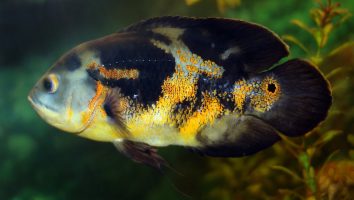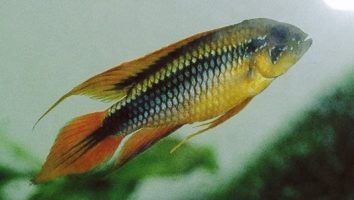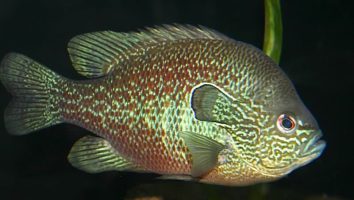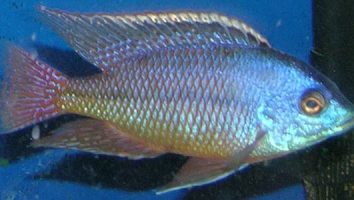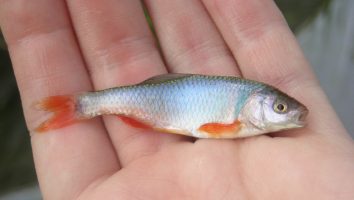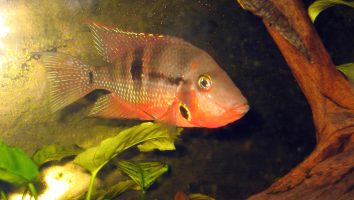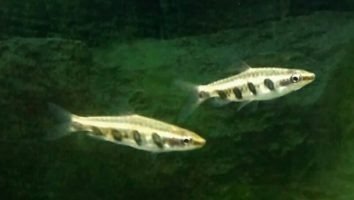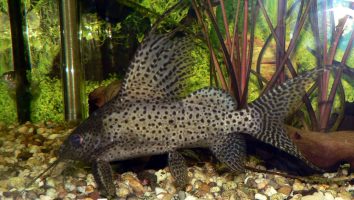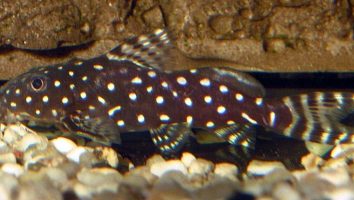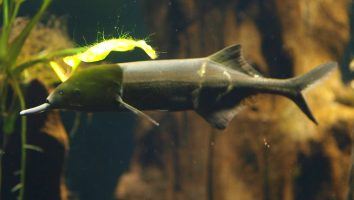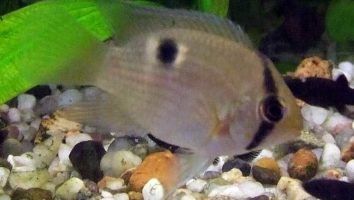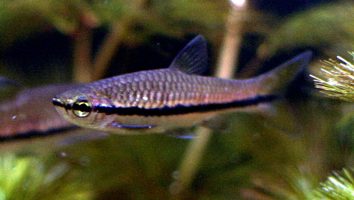The lemon cichlid is a beautiful and unique freshwater fish that is perfect for the beginning aquarist. They are relatively easy to care for and are very peaceful, making them a great addition to any community tank.
This guide will teach you everything you need to know about lemon cichlid care. You’ll learn about their diet, size, lifespan, and more!
Table of contents
Species overview
Lemon cichlids (scientific name: Neolamprologus leleupi) are found in Lake Tanganyika in East Africa. They are native to the countries of Zambia, the Congo, and Tanzania.
They inhabit the sandy shores of the lake and can be found in large groups. In the wild, these fish are known to be very peaceful and tolerant of other fish species.
Lemon cichlids are very popular in the aquarium scene due to their beautiful yellow coloration. They are also known to be very hardy fish, which means they are a good choice for beginner aquarium enthusiasts.
Appearance
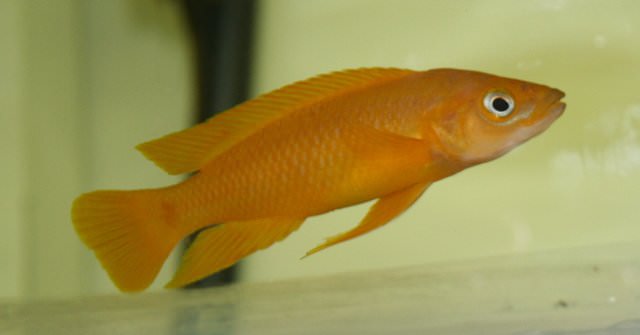
The Lemon Cichlid is definitely one of the more drab-looking fish on this list. As their name implies, these fish are mostly yellow with a few darker stripes running vertically down their body.
The fins on a Lemon Cichlid are pretty standard for a freshwater fish. They have a dorsal fin that starts about two-thirds of the way back and an anal fin of similar size and shape. Both of these fins are fairly tall and thin.
The caudal fin is forked and symmetrical. The pectoral fins are small and round. The ventral fins are also small and begin just below the middle of the fish.
One thing that stands out about the Lemon Cichlid is their eyes. These fish have large eyes that really stand out against their body.
Lifespan
Lemon cichlids have a lifespan of 10 to 15 years. This is a pretty long time for such a small fish!
As with any animal, there are a number of factors that can impact the lifespan of lemon cichlids. Poor water quality, for instance, will shorten their lifespan significantly.
Stress from bad tank mates or a suboptimal diet can also cause problems. If you take good care of your lemon cichlids, though, they should be able to live a long and happy life.
Size
Lemon cichlids can grow to be about 10 inches in length. However, most will max out at about 8 inches. These fish are relatively small compared to other cichlids, making them a good choice for a smaller aquarium.
Tank
Tank Size
The minimum tank size for a lemon cichlid is 30 gallons. If you want to keep more than one fish, you should add at least 20 gallons for each additional fish.
Water Parameters
The lemon cichlid is a freshwater fish that is native to the Atlantic coast of Central America. In the wild, they can be found in brackish water, but they will do just fine in a freshwater aquarium.
Lemon cichlids are not particularly demanding when it comes to water parameters, but they do prefer water on the alkaline side. A pH of 7.5 to 8.5 is ideal.
They also prefer water that is on the hard side, with a hardness of 10 to 20 dGH being ideal.
As for water temperature, lemon cichlids prefer water that is on the warm side, with a temperature of 76 to 82 degrees Fahrenheit being ideal.
What To Put In Their Tank
Lemon cichlids are a bit more delicate than some of the other cichlid species on this list. As a result, we recommend a setup that’s a little more on the natural side.
Gravel or sand will work just fine for the substrate. We recommend going with something on the finer side since these fish like to sift through it looking for food.
When it comes to plants, you have a few different options. Lemon cichlids have been known to nibble on vegetation, but this varies from fish to fish. You can try something like Hornwort or Java Moss and see how it goes.
As for other decorations, rocks and driftwood are both good choices. Just make sure that anything you put in their tank is smooth and free of any sharp edges.
One thing we would recommend avoiding is anything that’s too small. These fish are known to sift through substrate and decorations looking for food. If something is small enough, they might mistake it for food and try to eat it.
Common Diseases
The lemon cichlid is a pretty hearty fish, but that doesn’t mean they can’t fall ill from time to time. The most common diseases that these fish experience are the usual freshwater culprits.
Ich is the most common, but various other infections and parasites can strike too. Be on the lookout for anything out of the ordinary so you can act fast.
White spots, scars, cuts, or a change in behavior are all causes for concern. Even a disease that isn’t very severe can progress into something serious if left untreated.
When you notice something it’s important to act fast. Consult your vet and begin treatment immediately. The sooner you act, the higher the chance is that your fish will recover.
Of course, the best way to keep the risk of disease low is by simply keeping the tank in great shape. Not providing clean, high-quality water conditions will significantly increase the chance of your lemon cichlid getting sick.
Behavior & Temperament
The lemon cichlid is a beautiful fish that is known for being quite peaceful. It’s also known to be a great beginner fish for aquarists who are just starting out.
Lemon cichlids are relatively small, only growing to be about 4 inches in length. They are very peaceful fish and get along well with other fish that are similar in size. They are also known to be good community fish.
While they are peaceful fish, they are also known to be aggressive when it comes to breeding. When they are ready to breed, the male and female will become very aggressive towards each other. They will also become aggressive towards any other fish that come too close to their breeding area.
Lemon cichlids are also known to be good parents. Once they have laid their eggs, the parents will take turns guarding the eggs and fry. The parents will also continue to care for the fry until they are big enough to fend for themselves.
Tank Mates
Lemon cichlids are native to Central America. As a result, they’re used to warm water.
The ideal water temperature for a lemon cichlid is between 77 and 86 degrees Fahrenheit. This is on the higher end of the spectrum for freshwater fish.
Lemon cichlids are also semi-aggressive. They’re not the most belligerent cichlid out there, but they’re not the friendliest either.
With that in mind, it’s best to choose tank mates that can hold their own.
Some good options include:
- Convict Cichlid
- Jack Dempsey
- Firemouth Cichlid
- Green Terror
- Oscar
- Blood Parrot
Breeding
The lemon cichlid is a beautiful fish that’s relatively easy to breed in captivity. They’re not too picky about water conditions, but there are a few things you should do to ensure a successful spawn.
First, set up a breeding tank that’s at least 50 gallons. The tank should have a sandy bottom and plenty of hiding places. Driftwood, rocks, and caves all make good options.
Then, adjust the water temperature to between 78 and 82 degrees Fahrenheit. The pH should be between 7.5 and 8.5.
Once the tank is set up, add two females for every male. These fish are polygamous, so the male will mate with all of the females.
Lemon cichlids are mouthbrooders. That means the female will hold the eggs in her mouth until they hatch. After the fry are born, she’ll keep them in her mouth for another two weeks or so.
The fry are pretty big when they’re first born, so you don’t have to worry about feeding them live food. You can give them cichlid pellets or flakes. Just make sure they’re small enough for the fry to eat.
Conclusion
The Lemon Cichlid is a beautiful fish that is sure to brighten up any tank. They are relatively easy to care for and get along well with other fish.
While they are not the most active fish, they are still interesting to watch and add a splash of color to your tank.
If you are looking for a fun and easy to care for fish, the Lemon Cichlid is a great choice!

